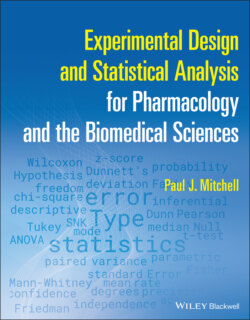Читать книгу Experimental Design and Statistical Analysis for Pharmacology and the Biomedical Sciences - Paul J. Mitchell - Страница 14
Example 2:
ОглавлениеI was once stopped in the corridor by a fellow post‐doc (and close friend) who described a series of experiments involving cell culture in different mediums which they were unsure how to analyse. Essentially, the post‐doc had a single flask of a particular CHO cell line and was trying to determine which of three mediums promoted the best cell growth. Three further flasks were prepared each one containing a different medium, and a sample of the cell line was decanted into each of the three test flasks. Sometime later, three samples were taken from each flask (so nine samples in total) and the number of cells per unit volume determined. The question was; ‘how do I analyse the data? Do I do a number of t‐tests (are they paired)? Do I do ANOVA? And if so, which post hoc test (don't worry I'll explain all these terms later in the book)’. I looked at the data, checked I had the right information about the design of this simple experiment and said ‘Sorry, you don't have enough data for statistical analysis – you only have an n of one in each case’. The post‐doc stared at me quizzically and said, ‘Don't be daft, I have n of 3 for each medium!’. ‘Er…, no!’, I replied, ‘You estimated the cell numbers in triplicate, but that only gives you n = 1 in each case, all you've done is obtain an estimate of precision and hopefully accuracy of your estimates, but that doesn't change the fact that you've only got n = 1 for each flask’. ‘No, no, no!’ the post‐doc strenuously exclaimed, ‘I have n = 3 in each case, three samples from each flask for the different mediums!’. ‘Er, no!’, I replied (at the risk of repeating myself), ‘If you wanted to do this properly then you should have prepared three flasks for each medium (so nine flasks in total), and decanted the same volume of CHO cells into each flask. Sometime later, you should then have taken 3 samples from each flask (so 27 samples) and estimated the cell number in each case. You would then calculate the average for each flask so that you get an improved accurate measure of the cell concentration in each flask (thanks to the measures in triplicate). This will then give you three measures for each medium which you can analyse by one‐way ANOVA followed by a Tukey All Means post hoc test (don't worry about these terms; all will become clear later in the book. I just included them to impress you, whet your appetite for what is to come and to try and convince you I know what I'm talking about!). The post‐doc looked at me aghast! ‘I don't have time for that!’, came the reply, ‘I have a group meeting with my Prof. this afternoon and I need to present this data so we can discuss which medium to use in our future studies – our latest grant proposal depends on demonstrating that one of these mediums is significantly different from the others, so I need to subject these data to statistical analysis!’. I looked at the summary bar chart the post‐doc had prepared from the data and it was clear from the eye‐ball test (this is probably one of the best tests to use to appreciate data and is very simple to perform – I'll reveal how later in the book!) that one of the mediums showed clear advantages in terms of cell growth than the others. ‘Just look at your data’, I said, ‘Medium X is clearly better than Y or Z, that's all you have to say!’. (This statement refers to one of the other very common statistical test; the IBO test. Er…, IBO is defined as ‘It's Bloody Obvious’). ‘That's no good’, replied the post doc ‘Prof likes to see stars (so thump him, I thought but didn't say out loud), and the more stars the better and happier he'll be’. (So, thump him harder? At this point, I'm left with the thought, what is the difference between a five years old starting Primary School and a 50 years old Prof leading a prestigious research group? Answer = absolutely nothing, they both like stars, preferably gold!] ‘Not with these data’, I said resignedly, ‘you've only got n = 1 for each medium and you can't perform rigorous statistical analysis with such a paucity of data.’ ‘Never mind’ said the post doc ‘I'll do it my way. Thanks.’ and disappeared down the corridor repeatedly muttering ‘1‐way ANOVA and some bloody post hoc test’. My words were left hanging in the ether!
The problem here is ignorance about n numbers leading to poor experimental design, a lack of understanding of the term ‘triplicate’ and the consequences that this has for statistical analysis. This is a very simple error that is commonly seen.
